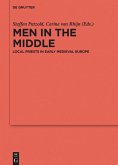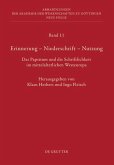In the past the ethnic duality of the Visigoths and the Hispano-Romans has been seen as one of the main characteristics in the formation of the Spanish Visigothic kingdom. This study shows that, instead of an ethnic division of the population, a Gothic identity, which was above all politically defined, was already applied to the entire population in the 6th century, and that overall it had less effect than is generally assumed. An analysis of the extant literary sources takes into account the historical conditions and new methodical approaches to interpretation.
Für die Migrationsphase der barbarischen gentes wurde gezeigt, dass ihre ethnische Identität als situationsabhängige Identifikation beschrieben werden muss. Diese Erkenntnis ist für die Untersuchung der barbarischen Nachfolgereiche bisher jedoch weitgehend folgenlos geblieben. So stellt auch im Falle des spanischen Westgotenreiches die klare Differenzierung zwischen eingewanderten Goten und sogenannten Hispano-Romanen nach wie vor eine wesentliche Prämisse für das Verständnis der historischen Prozesse im Übergang von der römischen Provinz zum regnum dar. Diese Untersuchung wertet die überlieferten Schriftquellen hinsichtlich der Fragen aus, inwieweit sie diese Unterscheidung stützen können und welches Verständnis der gotischen Identität sie erkennen lassen. Es hat sich dabei gezeigt, dass das Ethnonym Gothus mit einer politisch-sozialen Identität verbunden und in Bezug auf das regnum nicht in Abgrenzung zu Romanus verwandt wird, sondern dessen gesamte Bevölkerung einschließt.Es wird ferner deutlich, dass die gotische Identität vor allem auf der Durchsetzung überregionaler politischer Strukturen fußte, in welche sich die einheimischen Eliten, teilweise gezwungenermaßen, integrierten und deren Identität sie adaptierten.
Für die Migrationsphase der barbarischen gentes wurde gezeigt, dass ihre ethnische Identität als situationsabhängige Identifikation beschrieben werden muss. Diese Erkenntnis ist für die Untersuchung der barbarischen Nachfolgereiche bisher jedoch weitgehend folgenlos geblieben. So stellt auch im Falle des spanischen Westgotenreiches die klare Differenzierung zwischen eingewanderten Goten und sogenannten Hispano-Romanen nach wie vor eine wesentliche Prämisse für das Verständnis der historischen Prozesse im Übergang von der römischen Provinz zum regnum dar. Diese Untersuchung wertet die überlieferten Schriftquellen hinsichtlich der Fragen aus, inwieweit sie diese Unterscheidung stützen können und welches Verständnis der gotischen Identität sie erkennen lassen. Es hat sich dabei gezeigt, dass das Ethnonym Gothus mit einer politisch-sozialen Identität verbunden und in Bezug auf das regnum nicht in Abgrenzung zu Romanus verwandt wird, sondern dessen gesamte Bevölkerung einschließt.Es wird ferner deutlich, dass die gotische Identität vor allem auf der Durchsetzung überregionaler politischer Strukturen fußte, in welche sich die einheimischen Eliten, teilweise gezwungenermaßen, integrierten und deren Identität sie adaptierten.







